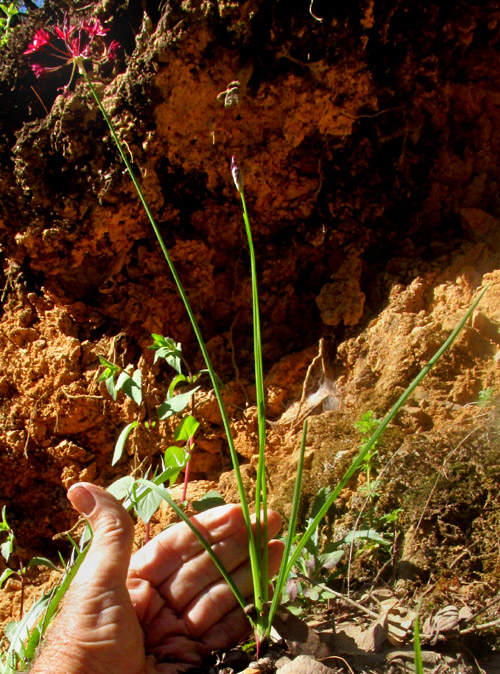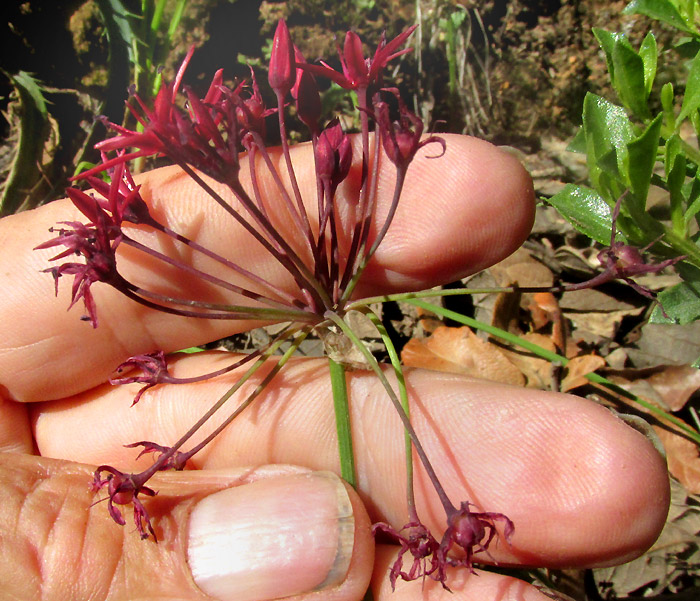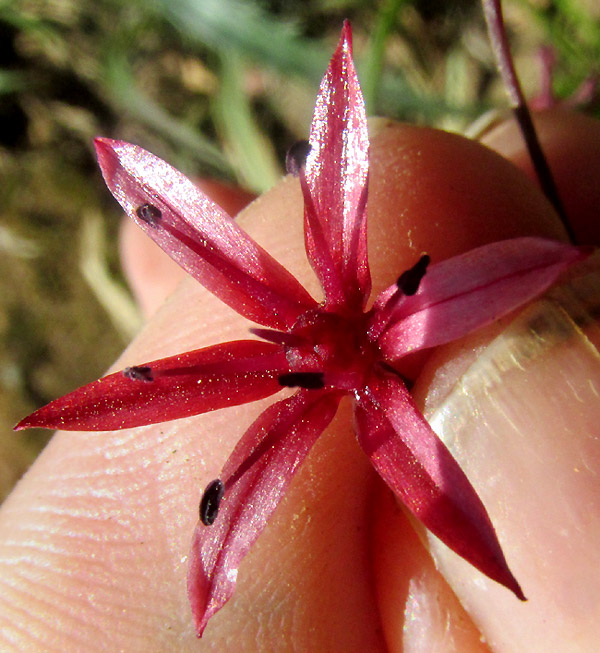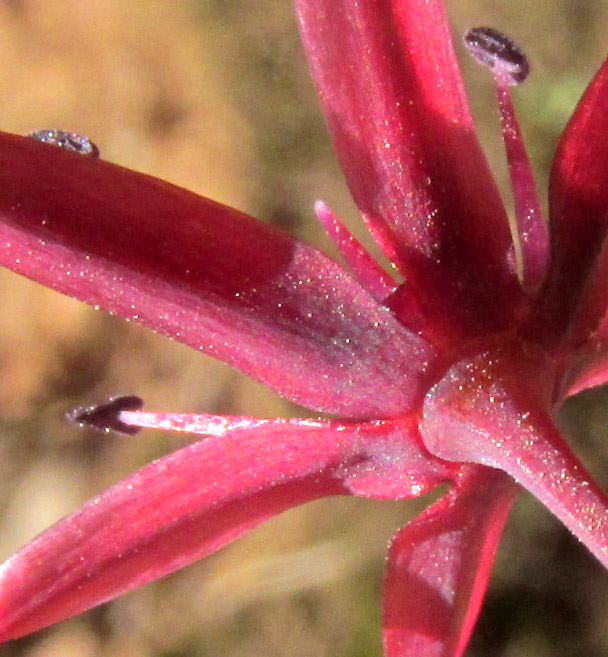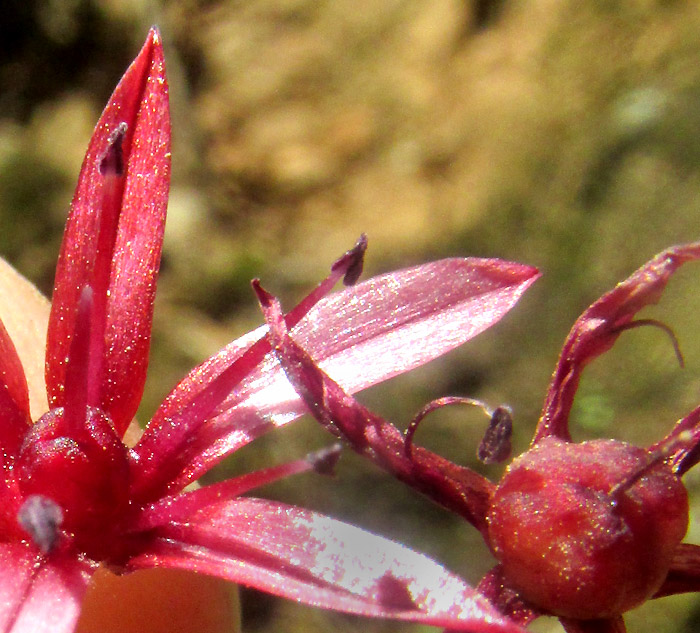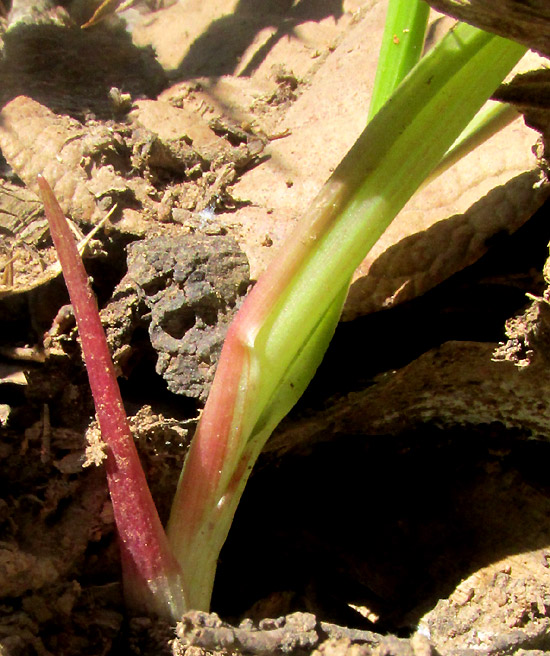Excerpts from Jim Conrad's
Naturalist Newsletter
Entry from field notes dated September 3, 2023, taken in Los Mármoles National Park in the Eastern Sierra Madre mountains, Hidalgo state, MÉXICO; oak-pine forested mountain, on road between Trancas {on maps designated "Morelos (Trancas)"} and Nicolás Flores, about 1.2km NW of Jagüey; limestone bedrock; elevation ~2,460m (~8,070); N20.808°, W99.237° Entry from field notes dated September 3, 2023, taken in Los Mármoles National Park in the Eastern Sierra Madre mountains, Hidalgo state, MÉXICO; oak-pine forested mountain, on road leading to Puerto de Piedra, which branches off the road between Trancas {on maps designated "Morelos (Trancas)"} and Nicolás Flores; limestone bedrock; elevation ~2,550m (~8,350); N20.811°, W99.219° Emerging from leaf litter gathered at the base of a roadcut through a steep slope's limestone outcrops, the above wildflower's globe-shaped flowering head atop a long, slender stem arising from a tuft of grasslike leaves looked just like some kind of wild onion, genus Allium. A sniff of a crushed leaf tip smelled oniony, confirming the ID. It's an umbel-type inflorescence, meaning that each blossom's stalk, or pedicel, arises from a common point atop the main stem, or scape, forming a flat or curved surface. The above umbel consists of unopened flower buds, flowers in full bloom, and faded flowers whose ovaries are maturing into fruits. Onion flowers produce six stamens, each arising at the base of one of six tepals, tepals being the term used when no clear difference exists between the blossom's calyx's sepals and the corolla's lobes or petals. Note the spherical ovary in the flower's center, topped with a toothpick-like style. Tepals and stamens arise below the ovary, so the ovary is superior, not inferior with tepals and stamens arising atop it. Mainly the above picture is provided because the flower's structure is so elegant that it's a pleasure to admire. It's the same with the following picture: That picture better shows the ovary, on the left, and an immature, capsular-type fruit on the right. Around the fruit, the tepals and stamens are drying up. I read that in this species the parent bulb disappears by flowering time, its stored nutrients used to produce the above-ground parts. However, roots remain and one to four or more new bulbs may develop on them, providing the next season's new plants. Balancing the ease with which we can recognize the onion species, genus Allium, is the matter that Allium taxonomy still is a mess, with the boundaries between species often unclear. At this time, estimates of the number of onion species worldwide range from as low as 260 to as many as 979. The vast majority of Allium species occur in the Northern Hemisphere's temperate zones; our central Mexican highlands are temperate enough to host a few species. The 2022 study by José Luis Villaseñor and others entitled "Riqueza y distribución de la flora vascular del estado de Hidalgo, México" lists four Allium species for our upland central Mexican state of Hidalgo. (The Flora of North America lists 96 for North America.) Of Hidalgo's four species, our plant, distinguished by its inflorescence's particularly numerous magenta flowers, in the literature currently available is identified as Allium kunthii. However, Kew's Plants of the World database at this writing considers that name as a synonym of an earlier published name, ALLIUM LONGIFOLIUM. Allium longifolium inhabits dry, rocky hills and mountains, usually in limestone soils, from southeastern Arizona to southwestern Texas, south throughout Mexico's uplands to about Oaxaca, maybe farther into Guatemala. Despite its presence in the US, it appears to have no accepted common name other than Kunth's Wild Onion, which makes no sense if its species name isn't kunthii. Numerous publications mention whole plants of what they call Allium kunthii traditionally being eaten, either raw or added into stews. In the 2002 book by Haim Rabinowitch and Lesley Currah entitled Allium Crop Science: Recent Advances, it's related that in Mexico our plant is semi-cultivated for its bulbs by the Tarahumara and Tzeltal people.
ALLIUM LONGIFOLIUM